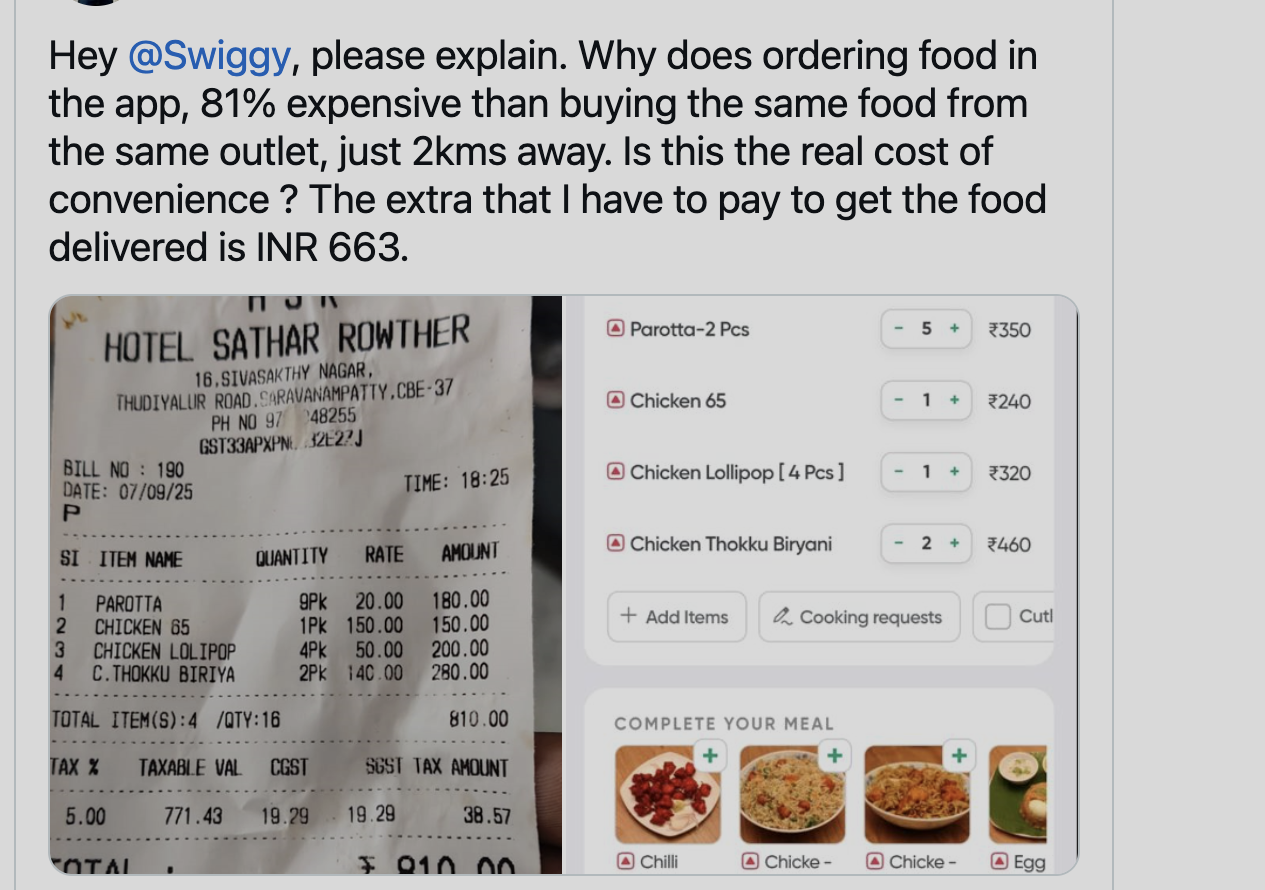A Coimbatore-based Swiggy customer has sparked a big debate on social media after claiming that ordering food through Swiggy cost him 80% more than buying the same items directly from the restaurant. The incident has raised questions about app pricing, restaurant markups, and the cost of food delivery convenience.
The Incident: Online vs Offline Bill
The customer, Sunder (@SunderjiJB), shared a detailed comparison on X (formerly Twitter). His Swiggy order of 10 parathas, chicken 65, four chicken lollypops, and two plates of chicken thokku biryani cost him Rs 1,473, including delivery and platform charges.
Buying the same dishes directly from the restaurant, located just two kilometers away, would have cost only Rs 810.
Price Differences:
-
Paratha: Rs 35 (Swiggy) vs Rs 20 (Offline)
-
Chicken 65: Rs 240 (Swiggy) vs Rs 150 (Offline)
-
Chicken Lollypop: Rs 320 (Swiggy) vs Rs 200 (Offline)
-
Biryani: Rs 230 (Swiggy) vs Rs 140 (Offline)
Sunder asked whether this steep markup was “the real cost of convenience,” triggering wide discussion online.
Social Media Reactions: Mixed Opinions
Many users were shocked by the 80% price difference.
-
Yashodhan G (@y2k_netizen) said, “30% difference is normal, but 80% is too much.”
-
Sushant Mehta (@SkyBarrister) defended the app: “You are free to choose. Delivery platforms and manpower need their cut.”
-
Aarushi Panchal (@panaaru) added, “Restaurants themselves set these prices to cover commissions. It is not Swiggy’s charge.”
Some pointed out that restaurants often inflate prices on Swiggy or Zomato to cover the 24–28% platform commission. Experts warn that this trend may affect the long-term sustainability of food delivery platforms.
Swiggy Responds: Pricing Is Restaurant’s Choice
Swiggy has stated multiple times that it does not control menu prices. A Swiggy Cares representative mentioned:
“Prices online may differ from offline. This is entirely at the discretion of the restaurant.”
Similarly, Zomato’s prospectus explains that restaurants may pay commissions and fund platform advertisements, which can affect customer-facing prices.
Convenience vs Cost: What Consumers Think
This incident has sparked a larger discussion on urban food delivery. While many customers accept moderate markups for home delivery, the extreme 80% increase has made people question transparency and fairness.
Some consumers are now checking restaurant menus before ordering online, while others argue that convenience and safety are worth the extra cost.
FAQs
Why are Swiggy prices higher than offline restaurants?
Restaurants set higher prices online to cover platform commissions and delivery charges. Swiggy does not directly control these prices.
Is it safe to order from Swiggy despite high prices?
Yes, food delivery platforms maintain hygiene and timely delivery. The extra cost is mainly for convenience, safety, and platform fees.
How much commission do platforms charge restaurants?
Swiggy and Zomato typically charge 24–28% commission on each order. Some restaurants also pay for advertisements on the app.
Can customers demand same prices online and offline?
No, online pricing is at the restaurant’s discretion. Customers should compare menus and choose wisely.
Conclusion
Sunder’s Coimbatore post highlights the hidden cost of convenience in online food delivery. While apps like Swiggy provide comfort and safety, they can also significantly inflate prices. Customers are increasingly aware of this markup and are debating whether convenience is worth the extra money.
Transparency in pricing, consumer awareness, and restaurant accountability remain key concerns for the food delivery ecosystem.

